Marrying Vega and Zen: The AMD Ryzen 5 2400G Review
by Ian Cutress on February 12, 2018 9:00 AM ESTBenchmarking Performance: CPU Rendering Tests
Rendering tests are a long-time favorite of reviewers and benchmarkers, as the code used by rendering packages is usually highly optimized to squeeze every little bit of performance out. Sometimes rendering programs end up being heavily memory dependent as well - when you have that many threads flying about with a ton of data, having low latency memory can be key to everything. Here we take a few of the usual rendering packages under Windows 10, as well as a few new interesting benchmarks.
All of our benchmark results can also be found in our benchmark engine, Bench.
Corona 1.3: link
Corona is a standalone package designed to assist software like 3ds Max and Maya with photorealism via ray tracing. It's simple - shoot rays, get pixels. OK, it's more complicated than that, but the benchmark renders a fixed scene six times and offers results in terms of time and rays per second. The official benchmark tables list user submitted results in terms of time, however I feel rays per second is a better metric (in general, scores where higher is better seem to be easier to explain anyway). Corona likes to pile on the threads, so the results end up being very staggered based on thread count.

Blender 2.78: link
For a render that has been around for what seems like ages, Blender is still a highly popular tool. We managed to wrap up a standard workload into the February 5 nightly build of Blender and measure the time it takes to render the first frame of the scene. Being one of the bigger open source tools out there, it means both AMD and Intel work actively to help improve the codebase, for better or for worse on their own/each other's microarchitecture.
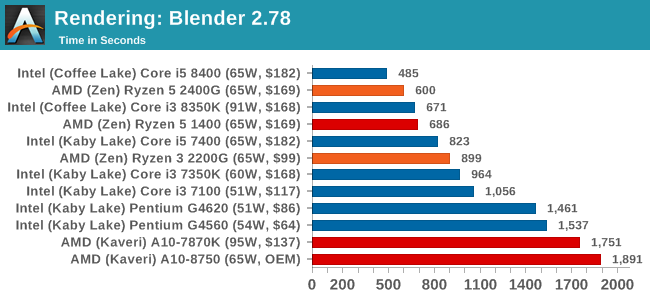
LuxMark v3.1: Link
As a synthetic, LuxMark might come across as somewhat arbitrary as a renderer, given that it's mainly used to test GPUs, but it does offer both an OpenCL and a standard C++ mode. In this instance, aside from seeing the comparison in each coding mode for cores and IPC, we also get to see the difference in performance moving from a C++ based code-stack to an OpenCL one with a CPU as the main host.
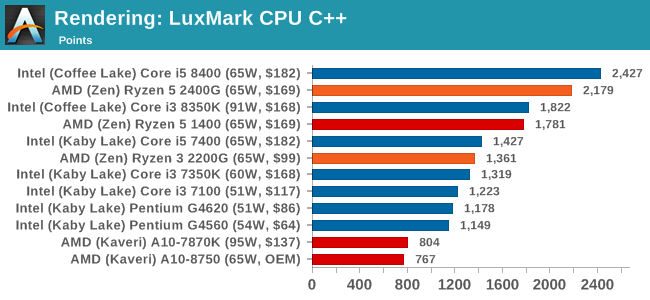
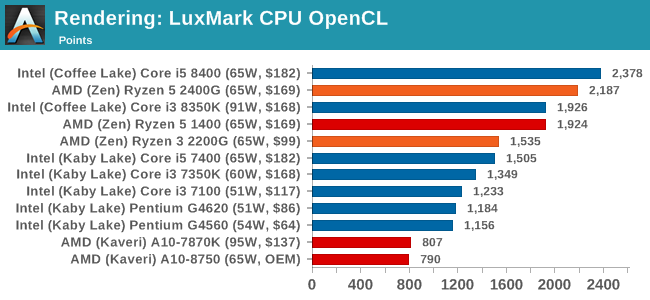
POV-Ray 3.7.1b4: link
Another regular benchmark in most suites, POV-Ray is another ray-tracer but has been around for many years. It just so happens that during the run up to AMD's Ryzen launch, the code base started to get active again with developers making changes to the code and pushing out updates. Our version and benchmarking started just before that was happening, but given time we will see where the POV-Ray code ends up and adjust in due course.
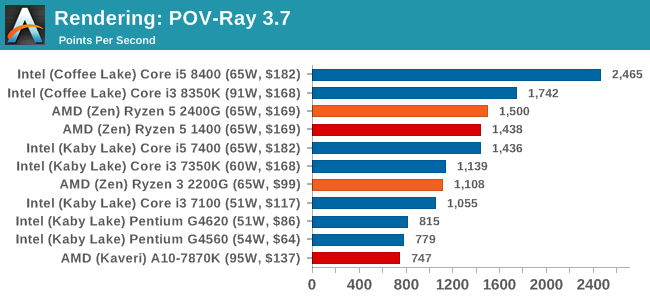
Cinebench R15: link
The latest version of CineBench has also become one of those 'used everywhere' benchmarks, particularly as an indicator of single thread performance. High IPC and high frequency gives performance in ST, whereas having good scaling and many cores is where the MT test wins out.
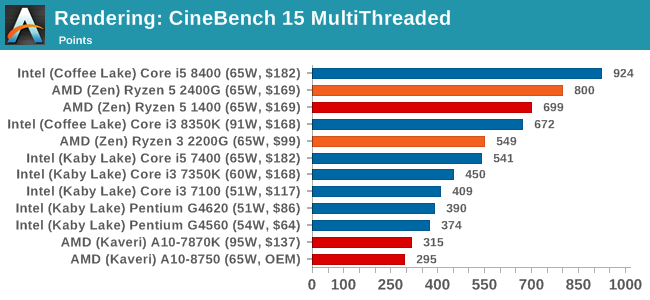

Conclusions on Rendering: It is clear from these graphs that most rendering tools require full cores, rather than multiple threads, to get best performance. The exception is Cinebench.










177 Comments
View All Comments
coolhardware - Monday, February 12, 2018 - link
I have been holding on to my Intel 2500K desktop for what seems like forever. It has been a trusty companion but with a TDP of 95W and a dedicated GPU pulling 100W+ I'm looking for something a little less power hungry. AMD seems to have what I've been looking for and the price is right :-)Amazon has the 2400G in stock, http://amzn.to/2BVzSSn and I think I'm going to bite the bullet!
PS does anybody have a mobo recommendation for pairing with the 2400G? (stability is my main concern, probably won't OC since the 2400G should be a nice step up from my 2500K)
zaza - Monday, February 12, 2018 - link
if already have a decent GPU it is better to get the Ryzen 1600 instead. it is only 10 or 20$ more but you will get two extra and 8 extra PCIe lanes. These APU only make sense as a placeholder to get something better, for example building a working PC, then add a dedicated GPU later.haukionkannel - Monday, February 12, 2018 - link
Or this will get you very good office computer, without ever needing external GPU...forgerone - Tuesday, February 13, 2018 - link
EXACTLY!!! This is the market for Ryzen with Vega. Business PC's and Laptops and also economy gaming for the markets that can not afford discrete GPU AIB.coolhardware - Monday, February 12, 2018 - link
Cool, thanks for the tip! How is discrete non-gaming (desktop, Photoshop) GPU power usage these days? I live off the grid and so energy efficiency is a big plus. I do not game much so (SC2 and some lower end Steam games).Also, any suggestions for motherboards for 1600 or 2400G? Again, stability is top criteria for me.
Last question, what's the max number of video outputs for the 2400G? Thx!
coolhardware - Monday, February 12, 2018 - link
PS I currently have a GTX 960. It does look like a step down versus the 2400G, as ~1030 (similar benchs to 2400G) is quite a bit lower speed than a 960:http://gpu.userbenchmark.com/Compare/Nvidia-GTX-96...
Cellar Door - Monday, February 12, 2018 - link
The 960 is 2-3x the performance of this.Samus - Monday, February 12, 2018 - link
GTX960 is a $200+ GPU. It's substantially faster than any integrated graphics and probably will be for the next few years.msroadkill612 - Tuesday, February 13, 2018 - link
" I live off the grid and so energy efficiency is a big plus." - apuS are exactly what you should be using.WorldWithoutMadness - Monday, February 12, 2018 - link
then might as well wait for ryzen+ version.Seriously AMD need to release something akin to NUC using the Raven Ridge. They can rake quite a lot of market with that. I will change my office's PCs with those, better GPU and comparable CPU.